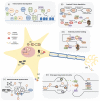Huntington's disease: underlying molecular mechanisms and emerging concepts
- PMID: 23768628
- PMCID: PMC3955166
- DOI: 10.1016/j.tibs.2013.05.003
Huntington's disease: underlying molecular mechanisms and emerging concepts
Abstract
Huntington's disease (HD) is a progressive neurodegenerative disorder for which no disease modifying treatments exist. Many molecular changes and cellular consequences that underlie HD are observed in other neurological disorders, suggesting that common pathological mechanisms and pathways may exist. Recent findings have enhanced our understanding of the way cells regulate and respond to expanded polyglutamine proteins such as mutant huntingtin. These studies demonstrate that in addition to effects on folding, aggregation, and clearance pathways, a general transcriptional mechanism also dictates the expression of polyglutamine proteins. Here, we summarize the key pathways and networks that are important in HD in the context of recent therapeutic advances and highlight how their interplay may be of relevance to other protein folding disorders.
Keywords: Huntington's disease; molecular mechanisms; therapeutic approaches.
Copyright © 2013 Elsevier Ltd. All rights reserved.
Figures

References
-
- Davies SW, et al. Formation of neuronal intranuclear inclusions underlies the neurological dysfunction in mice transgenic for the HD mutation. Cell. 1997;90:537–548. - PubMed
-
- DiFiglia M, et al. Aggregation of huntingtin in neuronal intranuclear inclusions and dystrophic neurites in brain. Science. 1997;277:1990–1993. - PubMed
Publication types
MeSH terms
Substances
Grants and funding
LinkOut - more resources
Full Text Sources
Other Literature Sources
Medical

